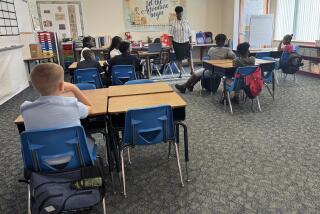L.A. Unified to Keep 16 Schools Segregated for Special Education
A federal judge is allowing the Los Angeles Unified School District to preserve 16 special education schools, prompted in part by protests from parents who want their disabled children in sheltered environments instead of integrated on regular campuses.
The dispute over the 16 schools illustrates the passionate debate surrounding special education.
Some parents and experts insist that students whose disabilities include blindness, cerebral palsy, mental retardation, autism and learning problems will progress and become socially accepted if they are mixed in with non-disabled students and given extra help. Such parents were represented in a 1993 lawsuit, named after a learning-disabled student, Chanda Smith, which alleged that special education programs in Los Angeles were a failure.
That suit led to a 1996 federal court order directing the district to integrate about 35,000 special education students into mainstream classrooms over the next few years.
Other families worry that their children will be traumatized in regular classrooms and that the children’s needs will be overlooked on campuses obsessed with academic test scores and football games.
Those parents prevailed in the most recent court proceeding. The decision will affect nearly 4,800 physically or mentally handicapped students at the 16 special schools. Under the 1996 court order, the school district would have been required to enroll non-disabled majorities at those sites.
The agreement to preserve the sites came after mediation between the school district and advocates of mainstreaming. It was approved last week by U.S. District Judge Ronald S.W. Lew, who had ordered the original integration plan. Though the 16 schools will stay mainly segregated for the disabled, the rest of the ambitious integration plan is still in force.
“We’re delighted,” said Harold Kwalwasser, general counsel for L.A. Unified. “We always opposed the elimination of special education schools .... The plan was simply a bad idea. It would not have resulted in a better education for these students.”
Without the change, those 16 centers would have had to reduce their enrollments of disabled youngsters to between 7% and 17% of their total student bodies. The district’s 660 regular campuses still are supposed to increase their special education populations to a similar range.
Parents who want to keep the more sheltered schools include Alex Gonzales, mother of a mentally retarded daughter who attends Miller High School for the disabled in Reseda. Gonzales and others had threatened to sue to prevent the 16 schools from being phased out.
Gonzales said parents and students were ecstatic when they heard the news last week that Miller would stay as it is.
“Every student deserves to be treated as an individual,” she said. “One-size-fits-all approaches to education are a recipe for miscommunication and disaster.”
Catherine Blakemore, one of the attorneys who filed the initial Chanda Smith lawsuit, said the recent mediation allowed parents on both sides of the debate to do what they think is best for their children.
“We’re striking a balance so that all children can get the services that are most appropriate for them.” she said.
An estimated 45,000 special education students, including many with learning disabilities, are already integrated, at least part time, at many regular Los Angeles schools.
Nearly 30,000 others attend segregated all-day classes at those mainstream campuses, and will be more integrated by 2006 under the court order. The 4,800 at the 16 sheltered centers can stay there if their parents want.
The integration will cost millions of dollars, district officials say, for hiring classroom aides, training teachers and principals and renovating buildings.
Many of the details are still being discussed in mediation.
Mary Falvey, an education professor at Cal State Los Angeles who co-wrote the district’s integration plan, initially advocated phasing out the 16 special schools.
Although she supports the settlement, she said she hopes children in those schools still will be exposed to the wider world.
“I still think kids who attend those school have a right to interaction with non-disabled peers,” Falvey said. “Several of the [special] schools have jump-started ways to create those opportunities.”
She referred to the Alfonso B. Perez School in East Los Angeles, a K-12 campus for 400 disabled students that also enrolls nearly 100 non-disabled students in kindergarten through third grades.
Other special education campuses also have added non-disabled preschools or activities that mix the groups, she said. Donnalyn Anton, associate superintendent of special education for the district, said the agreement shows that both sides can work together.
“There’s a strong, strong feeling among some parents of children at these centers that they’ve made the best choice for their kids where their kids are safe and getting programs that they need,” she said. “And there was a lot of resentment that someone else, some court edict or plan, would tell them what the best placement of their child was.”
Joy Efron, principal of Frances Blend school for the blind, who has rallied public support for the separate schools, called the agreement a “a great victory for students with disabilities and for their families,” she said. “This is a real validation of what special schools do in terms of teaching specialized skills, access skills, quality of life and self-esteem.”
*
16 L.A. Unified Schools for Special Ed
Sixteen special education schools and centers in the Los Angeles Unified School District were to be phased out, but now will be preserved. They are:
Banneker School, South Los Angeles.
Blend School, East Hollywood.
Lanterman High School, near downtown Los Angeles.
Leichman School, Reseda.
Lokrantz School, Reseda.
Lowman School, North Hollywood.
Lull School, Encino.
McBride School, Mar Vista.
Miller High School, Reseda.
Pacific School, Huntington Park.
Perez School, East Los Angeles.
Salvin School, near downtown Los Angeles.
Sellery School, Gardena.
West Valley School, Van Nuys.
Widney High School, Mid-City Los Angeles.
Willenberg School, San Pedro.
More to Read
Sign up for Essential California
The most important California stories and recommendations in your inbox every morning.
You may occasionally receive promotional content from the Los Angeles Times.










